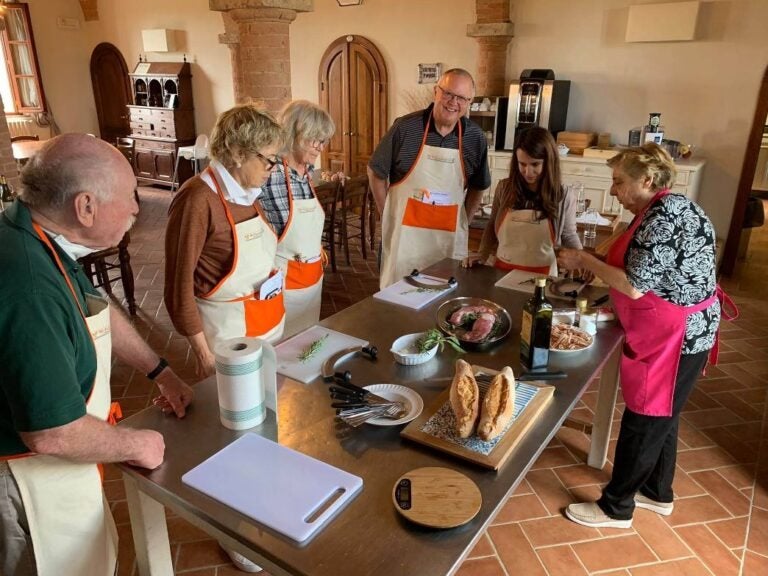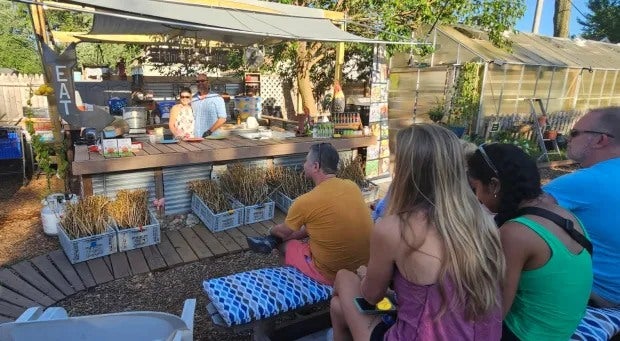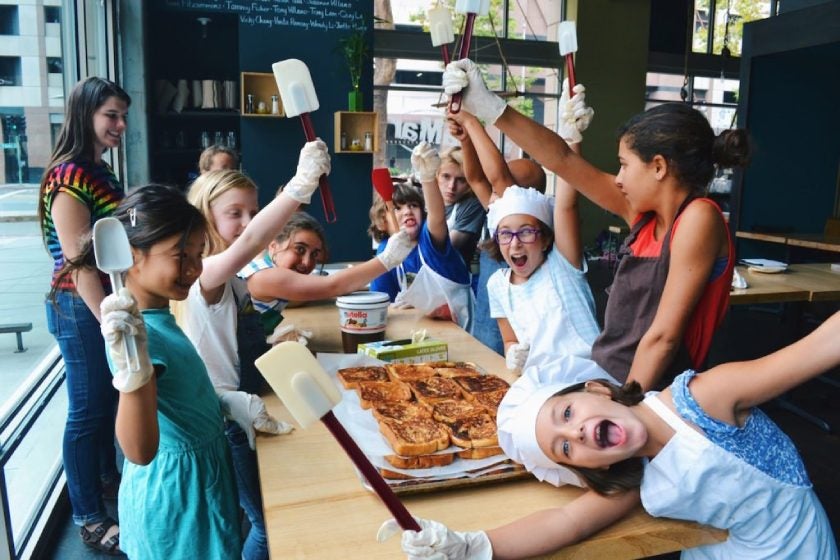Offering cooking classes is a way to capitalize on customers’ desire to try new food they are normally not able to cook at home—diversifying your revenue streams, showcasing your authority, and strengthening customer loyalty. You can hold cooking classes at a restaurant you own, virtually, in a rented space, or even at someone’s home. The […]
Offering cooking classes is a way to capitalize on customers’ desire to try new food they are normally not able to cook at home—diversifying your revenue streams, showcasing your authority, and strengthening customer loyalty. You can hold cooking classes at a restaurant you own, virtually, in a rented space, or even at someone’s home. The process also involves figuring out the class’s pricing, marketing, and planning.
While it may require a lot of work, teaching cooking classes is also a fun event for you and your staff to collaborate in a new way. In this article, we break down how to host a cooking class that is successful, profitable, and valuable to your customers.
Key Takeaways:
Whether you have a restaurant or not, choosing a venue is not as simple as hosting it at an owned restaurant. The needs of a cooking class venue differ from those of a professional kitchen. A venue for hosting a cooking class must have an open layout, with full equipment handy and an easy view of the instructor from all workstations. It must also have enough capacity for the class size you intend to host.
Beyond this, your location must be easy to find and access. It also must be compliant with food safety and customer safety requirements, as these are both legally required and maintain a professional learning environment. Finally, the venue must also make sense cost-wise for your business to use it effectively. Below are some examples of cooking class venues you may choose to teach from:

Planning for the class and creating a product customers will want to come back to is the key to success. Proper planning can be the difference between offering a valuable experience or a disjointed piece of learning that does not resonate with your students.
Determine how the class will run, what ingredients and prep are needed before class, the flow and length of the class, which staff should be involved to teach, and more. Below are the key aspects to plan for your cooking class:
Pricing a cooking class is an important factor in ensuring that hosting the class is worth the effort. The average cost for a cooking class can be anywhere between $25 to $100 per hour and is dependent on a variety of factors:
A key way to ensure you meet your financial goals with your cooking class is by getting guests or students to come and join the class. The goal is to share what guests will learn from the class, when the class is, and where it is being held.
Marketing your class could be done by waitstaff when customers are cashing out. You can also post to social media channels for your business, sharing the class, what it offers, and the price to get in. Another great way to market a cooking class is by sharing it with local organizations, such as vocational schools or other community centers.

The keys to teaching a class are the recipes you decide to teach, the complexity of their components, and how simply you can break down each recipe when teaching. A student should be able to come to a class, learn how to cook that recipe, and then leave and replicate it for family and friends. This goal should shape the recipes you choose, the complexity of the cooking skill required, and your confidence in your or your staff’s ability to teach students the recipe effectively.
Food safety—and guiding your students on proper food safety measures—is a major focus for all cooking classes. Ensuring each workstation is clean, sanitized, and equipped is vital to teaching a cooking class. Teaching how often handwashing should occur and demonstrating how to do it are also vital pieces in a cooking class. Finally, as the instructor or organizer, you should be diligent about being present and managing mistakes and food safety risks.
Working with students can be very engaging and rewarding. There is great joy in being able to teach someone a new skill set in the kitchen, especially if it’s something you take massive pride in yourself.
When teaching new students, it is important to empathize with the fact that cooking in a professional or highly proficient way is most likely new to them. Designing your class and teaching in an empathetic and approachable way will lead to success and minimize any frustrations you or your students may have when teaching. Working with students, wherever they are, will always have better outcomes when compared to teaching or talking down to them.
When a class is done, gather feedback from students and analyze where you or your team can do better. This helps you continually improve your class offerings. If your classes are hard and unapproachable, then it will be equally hard to convince students to return or new ones to sign up. If you can take feedback and tailor the cooking class to the needs of your students, you are more likely to get buy-in for them to return. This feedback will also lead to better first impressions for those coming to your cooking class for the first time.
While hosting a cooking class may sound like a good idea, it is fundamental to understand the different requirements you will need to host a cooking class for your business. If you do not meet the requirements for hosting a class, then class quality, food safety, and even your business’ reputation can be at stake.
Below are some of the key requirements you need to consider before deciding on hosting a cooking class.
Now that we have discussed the ins and outs of hosting a cooking class, it is time to discuss the different types of cooking classes you can hope to host within your business. The type of cooking class you choose to offer does not always need to match the menu items you have exactly, but the recipes you are teaching should have a place within the broader concept of your food business. Below are some of the best examples of cooking classes you may find offered throughout the industry.
Some of the most needed kitchen classes are classes that go over the basics of cooking. Knife cuts, butchery, cooking techniques, recipe building, and plating are often topics in these classes. These classes showcase your expertise in the food world and help students approach cooking with a solid foundation.
Advanced cooking classes are meant for those with a background in cooking fundamentals. These classes will showcase more in-depth and technical recipes, allowing for better growth for those who like to cook but want a deeper experience.
Cooking classes that focus on a set recipe or dish are often very easy for food businesses, as you are often teaching the same dish or recipe that is found on your menu. These cooking classes are also approachable and can garner interest if the recipe or menu item being taught is popular or unique to a broader audience. Below are some recipes that you can focus your cooking classes on:
As you can see, you can virtually teach any recipe you may sell or excel at as a business. Choosing a recipe that is popular or interesting enough to draw in students will be key for you to garner class interest.
One popular class type will be a cocktail or mocktail class. Usually hosted by a bartender, a class focused on mixology can be very popular due to the general interest customers have in making cocktails. Offering a fun cocktail class or a mocktail class that covers a popular cocktail can be a great way to get a larger student turnout.
Pairing wine and food is hard, so offering a class on what to cook with wine and how to pair wine with food is a great idea. The class will both teach cooking and wine pairings and can offer a lot of value to those who attend.
Helping customers make delicious, nutritionally-sound meals for the week can be a great reason to hold a cooking class. A lot of people struggle with cooking during the week, and teaching your key cooking skills to customers so they can have food ready to go during the week is something that many will appreciate.
Farm-to-table dining is popular, and teaching your students how to go to a farmer’s market and cook with what is available is a great skill to teach. These classes will include shopping for key ingredients at a farmer’s market and making a dish centered on the unique, fresh ingredients you found at the market.

Baking and desserts are two food types that are more difficult than some of the a-la-minute cooking the other classes cover. Teaching students how to make sourdough or instructing how to decorate a cake, can be a great class topic that many sign up for.
Lastly, cooking based on a region in the world is very popular. This could be dishes inspired by Spanish cooking, Italian cooking, or even Indian cooking. You can break out classes into sub-regions, pulling from unique culinary settings, to offer a variety of classes that are both fun to attend and informational.
There are a variety of benefits as to why you may want to host a cooking class:
Teaching a cooking class, first and foremost, opens up another revenue stream for your business. Restaurants and similar businesses often work on tight margins. Finding ways to branch out how you make your revenue is one of the key ways of succeeding in the food industry. Hosting cooking classes that are valuable to customers and profitable for your business is a great way to help the overall health of your food business.
Building a reliable food brand is how you build a loyal customer base. By offering cooking classes, you build your reputation as a leader in the food space while garnering loyalty and buy-in from customers who attend these classes. Furthermore, sharing how favorite dishes are made can lead to some awesome word-of-mouth advertising and a generally increased interest in what your business has to offer.
If you are a restaurant with merchandise, ready-to-eat (RTE) products, cookbooks, or other inventory to sell to customers, then hosting a cooking class can be a great way to sell these items. Cooking classes are engaging and allow customers to learn about the finer details of the food they love. Capitalizing on this interest in your business is smart, and upselling other items that may relate to your brand or the class itself is a great idea.
Cooking classes are great ways to build community and establish your brand within your city or region. Cooking classes showcase a business that is interested in developing deeper, more meaningful customer relationships. This speaks volumes to local communities and can be the reason why some customers choose your brand over another local business. Classes like this create a natural investment, which in turn creates a loyal customer base.

One fun aspect of running a cooking class is to have your staff help teach or be part of running the class. This could offer new skillset opportunities for your staff, especially back-of-house staff who do not get to work in a lot of customer-facing environments.
One of my favorite reasons for holding a cooking class is to teach about a new cuisine that your business is trying to introduce to a region. By breaking down key dishes of a new cuisine, you familiarize your customers with the food you are preparing. This understanding can help new concepts or cuisine types become more welcome and craved when introduced into new markets.
Below are some of the most commonly asked questions about hosting a cooking class.
A cooking class is facilitated by creating a lesson plan, finding a venue to teach, gathering the staff to teach, and ensuring ingredients and equipment are acquired for students. Being an expert in a cuisine type or being respected in your local region can be great advantages when trying to start hosting cooking classes.
Finding the right venue, detailing what your class will entail, and taking care of logistics regarding the class are the best ways to start a cooking class. Marketing to students is just as important as all of this, and getting the word out will ensure that you hit your attendance goals and deliver a great experience to those who show up.
Cooking classes can be profitable when priced correctly. Unlike a restaurant bill, cooking classes are a set price. Basing your price on a target profit margin against the cost of hosting the class is the best way to be profitable when hosting cooking classes.
Hosting a cooking class is great exposure for your business and deepens your relationship with the community your business is present in. Furthermore, a cooking class can open another revenue channel, adding to business profitability and attracting new customers. With proper planning, an exciting lesson plan, and approachable teaching methods, cooking classes can become a hallmark of your current food business.
Ray Delucci is a graduate of The Culinary Institute of America with a Bachelor’s in Food Business Management. He has experience managing restaurants in New York City, Houston, and Chicago. He is also the host of the Line Cook Thoughts Podcast, where he interviews and shares the stories of foodservice workers. Ray currently works in food manufacturing and food product development.
Property of TechnologyAdvice. © 2025 TechnologyAdvice. All Rights Reserved
Advertiser Disclosure: Some of the products that appear on this site are from companies from which TechnologyAdvice receives compensation. This compensation may impact how and where products appear on this site including, for example, the order in which they appear. TechnologyAdvice does not include all companies or all types of products available in the marketplace.